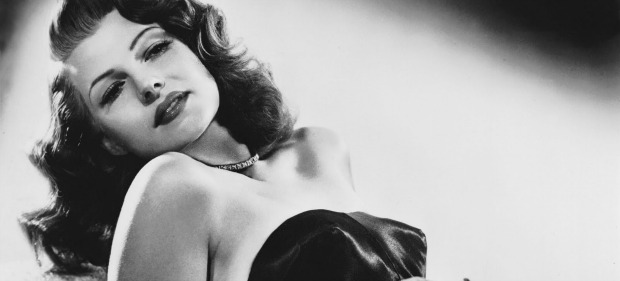
Put the Blame on Mame – or Gilda?

Gilda is about a scorchingly attractive woman (Rita Hayworth) who keeps breaking through the surface narrative of the film named after her. That narrative is about men – professional gambler Johnny Farrell (Glenn Ford) and sinister casino-owner and crime-boss Ballin Mundson (George Macready). Judging by how they meet, the fact that Johnny is given a key to Ballin’s house, the looks they exchange, and the tactile way they touch, Ballin and Johnny seem to have a sexual relationship, though this 1946 film couldn’t be more explicit for fear of Hollywood’s Production Code.
The film has been running for seventeen minutes before Gilda first appears. Ballin escorts Johnny into the threshold of a bedroom. For a nano-second, it seems to be an empty room. Then Hayworth appears, with her head down. She lifts her head, flinging back her impressive mane of hair. After that, it really is her film. It turns out that Ballin has married her impulsively the day he met her for the first time. It also becomes evident that Gilda and Johnny have been lovers. The stage is set for an intense three-way tussle of love, hate and revenge.
Gilda was originally designed as a noir-ish crime film (Humphrey Bogart turned down the role of Johnny Farrell), but it was also a film specifically intended as a vehicle for Hayworth, Columbia Pictures’ principal female star. The problem was that, although Hayworth had played a femme fatale in earlier movies – including The Strawberry Blonde and Blood and Sand (both 1941) – her recent roles had been as ‘good’ girls in musicals. She was Fred Astaire’s dance partner in You’ll Never Get Rich (1941) and You Were Never Lovelier (1942) – Astaire apparently claimed she was his favourite co-performer – and Gene Kelly’s in Cover Girl (1944). Studio boss Sam Cohn and producer Virginia Van Upp realised that Gilda would have to include scenes of Hayworth dancing and singing. The song ‘Put the Blame on Mame’ was written specifically for her by Doris Fisher and Alan Roberts. She sings it first of all alone in her bedroom, then to her friend, casino employee Uncle Pio (Steven Geray) and finally – the time everyone who has ever seen the film remembers – while dancing and wearing that ‘little black dress’ to embarrass Johnny in the casino he has by this stage inherited from Ballin. When she first appears, Gilda is asked by Ballin if she is ‘decent.’ Hitching up one shoulder of her dress (but very obviously not the other), she murmurs ‘Sure, I’m decent.’ Much of the rest of the film revolves around the issue of whether Gilda is or is not decent.
Gilda has a great script with some superb one-liners (‘Pardon me but your husband is showing’; ‘If I’d been a ranch, they’d have named me the “Bar Nothing”’). The sets, by designers Stephen Goossón and Van Nest Polglase, are at times sumptuous. But, in the end, it is Rita Hayworth in her greatest role who dominates the picture. She walks an insouciant line between the love and hatred of two men, always a bit surprised and quizzical at the emotional havoc she wreaks. Is Gilda a good girl or a bad girl? See the film (now in a brand-new print) and decide!







COMMENTS